EM Takes Safe, Unique Approach to Underground Demolition at Hanford Site, Saves Money The underground demolition occurred at the final reactor cleanup site in Hanford's 300 Area, a former industrial complex along the west bank of the Columbia River. RICHLAND, Wash. – Some people in the community heard an explosion the morning of Aug. 16 that heralded another significant step in environmental cleanup at EM's Hanford site. The noise and small plume of dust just 1.5 miles north of the city came from an underground demolition explosion safely completed with a unique approach that protected workers and saved taxpayers $2.5 million. Watch a video of the demolition here.* In January, the last of six test reactors was removed from the site where the demolition took place. The 1,082-ton Plutonium Recycle Test Reactor was lifted and transported to the site's Environmental Restoration Disposal Facility. Work associated with the massive underground structure that supported and shielded the test reactor was deferred until the best approach could be determined. Reaching as far as 60 feet below the surface, the structure had walls ranging in thickness from 5 to 13 feet and was covered by a 5-foot-thick main deck. The largest block of reinforced concrete was 18 feet long, 13 feet thick, and 28 feet high. "Some walls and the deck were made of a heavy aggregate concrete, which is almost twice as dense as regular concrete," said EM Richland Operations Office Federal Project Director Mark French. "This made the demolition especially challenging." In operation in the 1960s, it was the largest of Hanford's experimental reactors used for developing and testing alternative fuels for the commercial nuclear power industry. Preparations to remove the underground structure began in January when the reactor was lifted and hauled away. Workers removed piping and drums of contaminated materials. They also grouted hard-to-reach areas while applying fixative to areas with surface contamination. Controlled Demolition Incorporated — which had previously performed the stack and 337 Building demolition in the 300 Area — was again hired by the site's cleanup contractor Washington Closure Hanford to do the work. Controlled Demolition drilled approximately 300 holes loaded with explosives into the deck, columns, and walls. The blast effects were mitigated by a dust barrier placed on top of the structure, and mist to suppress dust. "This is a safer approach than to have the deck dismantled with machinery from above and working down into the structure," said Rob Cantwell, director of closure operations for Washington Closure. Their approach brought a cost savings of about $2.5 million compared to doing the same work with traditional demolition techniques. The rubble from the demolition explosion is expected to be removed by January 2015 and the area will be sampled. If it meets cleanup standards, some of the remaining structure will be buried in place. If not, a second demolition explosion will be scheduled. *Users who experience issues viewing video should consider updating their Internet browsers and/or using an alternate browser. Workers Create Demolition Zone at Hanford Site's Plutonium Finishing Plant RICHLAND, Wash. – In recent weeks, the look of Hanford site's Plutonium Finishing Plant has changed as crews removed or demolished eight buildings surrounding it. "We're getting ready to demolish all of the facilities at the Plutonium Finishing Plant," said Bryan Foley, deputy federal project director for EM's Richland Operations Office. "Taking down and removing these office buildings and support structures provides a change in the skyline at the plant that brings us closer to completing this important cleanup project." The buildings once supported operations in the plant that produced nearly two-thirds of the country's plutonium through the late 1980s. Workers removed the buildings to create a large demolition zone surrounding the plant's main buildings. The zone will allow the safe staging and operation of heavy equipment during final facility demolition. 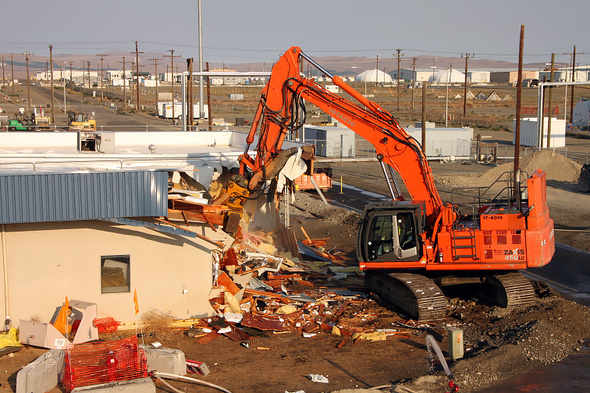  The former administration building known as building 270-Z is one of eight support buildings of the Plutonium Finishing Plant recently removed or demolished. "This is one of the most hazardous facilities at Hanford, and the team is safely taking the facility apart from the inside out," Mike Swartz, vice president for the plant closure project at CH2M HILL Plateau Remediation Company (CH2M HILL), said of the plant. CH2M HILL is EM's cleanup contractor at the site. "As we prepare to demolish the facility, we're ensuring that there is enough space around the main buildings to bring in heavy equipment and stage demolition debris prior to disposal, all to allow demolition progress to continue safely and compliantly," Swartz said. While heavy equipment outside the plant removes buildings no longer used, inside the plant, employees are removing plutonium processing equipment to prepare the plant itself for demolition. Since 2008, EM and its contractors have demolished or removed 61 buildings that once supported the plant's operations. The eight buildings removed over the past month include building 270-Z, which once housed the plant's administration offices. "The team has done an outstanding job preparing 270-Z for demolition, and then to complete the process safely and compliantly is a testament to the crew's dedication and experience," said Jeremy Hulquist, the plant's field work supervisor overseeing the recent demolition. "I appreciate everyone's commitment to safety and compliance throughout this process." The plant was the primary facility for producing plutonium at Hanford from the 1940s to the 1980s. Since 2008, EM and CH2M HILL have been cleaning out and removing hundreds of pieces of contaminated equipment from the plant and preparing some equipment for removal during demolition. About 70 percent of the facility is ready for demolition. Hanford Exceeds Annual Goal for Cleaning up Groundwater near Columbia River 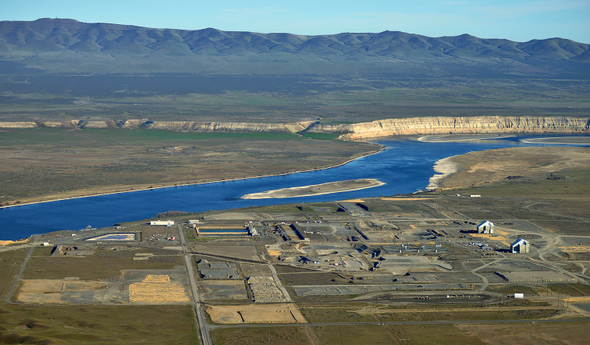 An aerial photo of Hanford's 100-D Area along the Columbia River, which is served by one of five pump-and-treat systems along the Columbia River that are helping shrink areas of contaminated groundwater. RICHLAND, Wash. – At the Hanford site in southeast Washington state, EM and its contractor CH2M HILL Plateau Remediation Company (CH2M HILL) are achieving groundwater cleanup goals ahead of schedule. This year, EM exceeded its annual goal for removing hexavalent chromium from groundwater four months ahead of schedule. "Our contractor removed more chromium than forecasted this year by pulling more groundwater from the areas of highest contamination," said EM Richland Operations Office's Soil and Groundwater Division Director Briant Charboneau. "Having extraction wells in the right place and adding new treatment systems over the past few years has been critical to our success in removing contamination from groundwater and protecting the Columbia River." 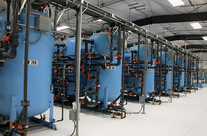 | |
Inside one of Hanford's five pump-and-treat systems along the Columbia River that are treating contaminated groundwater. | |
Nuclear Chemical Operator Mike Fish monitors operations of a pump-and-treat system at the Hanford site. | |  | Between October 2013 and the end of July, workers removed approximately 680 pounds of the contaminant, surpassing EM's goal to remove approximately 550 pounds by the end of the fiscal year on Sept. 30. The chromium contamination resulted from intentional and unintentional releases of chemicals in the soil from the site's plutonium production reactors. Much of the contaminated soil has been removed, and EM is operating treatment facilities along the river to address the remaining chromium contamination in groundwater. "Through our workers' efforts to maintain safe and optimum operations of our treatment technologies, we have been able to surpass EM's groundwater cleanup goals again this year, and that progress is visible," said Mark Cherry, CH2M HILL acting vice president of the Soil and Groundwater Remediation Project. EM operates five groundwater treatment systems along the Columbia River, supported by a network of approximately 150 wells. Contaminated groundwater is extracted through the wells and transferred to facilities for treatment. The treated water is injected back into the aquifer to help drive the contaminated groundwater toward the extraction wells. 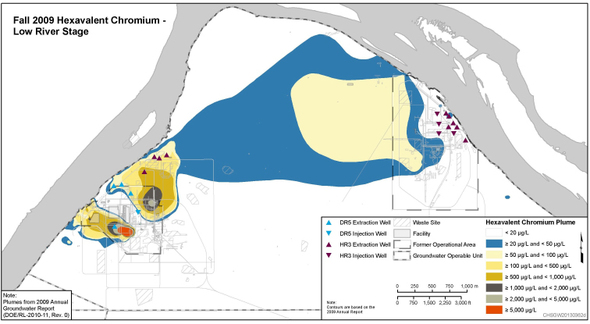 This graphic shows the area, or plume, of chromium contamination in groundwater near Hanford's D, DR, and H reactors in 2009. 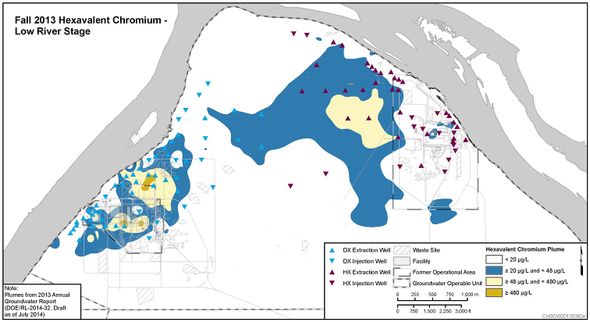 This graphic of the same area near Hanford's D, DR, and H reactors in 2013 shows reduced levels of the contaminant in groundwater after pump-and-treat operations significantly increased the amount of groundwater being treated per year. "We have been able to surpass our goals thanks to running our new and existing treatment facilities at greater capacities, having wells in the right areas, and using our employees' ideas to find ways to run the systems more efficiently," said Bill Barrett, CH2M HILL director of operations for the Soil and Groundwater Remediation Project. Since the mid-1990s, workers have removed approximately 3,000 pounds of hexavalent chromium from groundwater along the Columbia River. Videos about Hanford groundwater treatment capabilities and efficiencies are available here.* *Users who experience issues viewing video should consider updating their Internet browsers and/or using an alternate browser. WIPP Team Chosen as Overall Champion at National Mine Rescue Competition 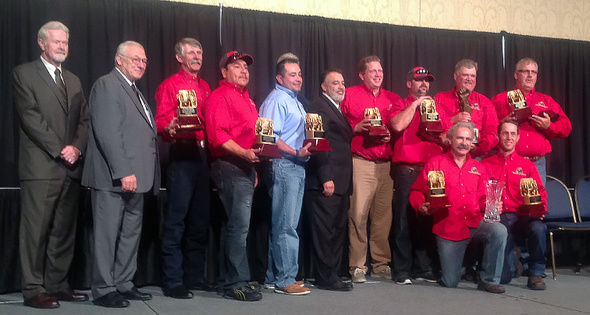 CBFO Manager Joe Franco (sixth from left) with the WIPP Red Team and competition officials at the 2014 National Metal and Nonmetal Mine Rescue Competition. CARLSBAD, N.M. – EM's Waste Isolation Pilot Plant (WIPP) Mine Rescue Red Team was selected as overall champion from among 41 teams that participated in the National Metal and Nonmetal Mine Rescue Competition in Lexington, Ky. this month. The top-spot honor comes just months after this team placed second in the Southwestern Regional Mine Rescue Competition in Carlsbad. WIPP has two mine rescue teams — red and blue — that regularly compete and show excellence in the demonstration of their knowledge and skills. In previous national competitions, both WIPP teams have participated. However, the Blue Team stayed in Carlsbad during this latest competition to support potential underground entries related to the WIPP recovery effort. "The most important aspect of the competitions is the vital mine rescue training provided for our teams," said Carlsbad Field Office (CBFO) Manager Joe Franco. CBFO has responsibility for WIPP and the National Transuranic (TRU) Program. "The teams' performance at these competitions validates proven mine rescue team procedures and processes," said Franco, who was manager for the WIPP mine rescue teams in the late 1990s. "CBFO, associated DOE contractors and laboratories, and the regional communities are all highly supportive of the WIPP mine rescue teams. We're very appreciative of what's involved for this dedicated group to be prepared to provide well-trained emergency response for our workers, facility, community, and the entire industry." "The competitions provide fundamental training and help ensure that if we have an emergency in the WIPP underground or other mines, the teams are ready to respond on short notice," said CBFO Mine Operations Project Manager Don Galbraith. The team members are employees of Nuclear Waste Partnership (NWP), the WIPP management and operating contractor. "We're incredibly pleased to have such high-caliber employees who stand ready to provide emergency response in the event of a mine disaster," said NWP President and Project Manager Bob McQuinn. "The WIPP teams' success is attributed to the hard work, experience, and dedication of the employees." The national mine rescue competition is held every two years. Teams are rated according to how well they follow basic Mine Safety and Health Administration (MSHA) rules and regulations in carrying out a rescue under adverse, disaster-like conditions. MSHA evaluates the teams through field, technician team, first aid, and team trainer challenges. The overall champion is determined by the team with the best average score in all events. WIPP, the nation's only deep geologic repository for the disposal of TRU waste, is unique as both a nuclear and mining operation. Given this dual nature, WIPP trains employees to meet federal requirements for both mine and nuclear operations. The mine rescue competitions provide venues for teams to test their mine rescue assistance agreements to provide emergency response with two local potash mines in New Mexico and a marble mine near Van Horn, Texas. The WIPP teams have benefited from the training and credit the state, regional, and national competitions with honing their skills. In February, members were called to enter the WIPP underground to ensure the salt truck fire was completely extinguished and to test for underground air quality. Several years ago, WIPP's teams assisted in the recovery of a man who had fallen into an abandoned mine shaft in central New Mexico. Energy Secretary Ernest Moniz Visits WIPP 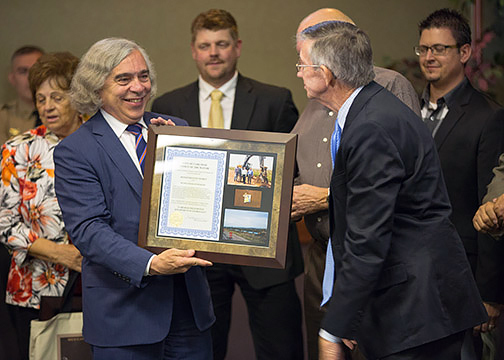 Energy Secretary Ernest Moniz accepts special recognition on behalf of DOE for support of the expansion and upgrade to Carlsbad's Double Eagle Water System from Mayor Dale Janway (right) at a town hall-style meeting this month. In the background are Carlsbad city counselors Janell Whitlock, Wesley Carter, and Jason Shirley. Recognizing the need for more potable water for a growing Carlsbad, the city years ago purchased the system from a water cooperative. The system will serve as a secondary source of water for residents. 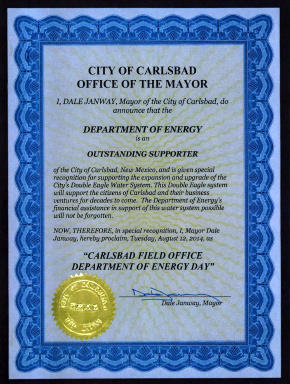 | |
Carlsbad Mayor Dale Janway proclaimed Aug. 12, 2014 "Carlsbad Field Office Department of Energy Day" in recognition of the DOE's support of the city's Double Eagle Water System, which will provide additional water for the expanding city. "I'm proud of the work you do and the support you continue to provide to the city, the nation, and the world," CBFO Manager Joe Franco told employees. "I very much appreciate your hard work, dedication, and perseverance as we move forward through our Waste Isolation Pilot Plant recovery phase." | 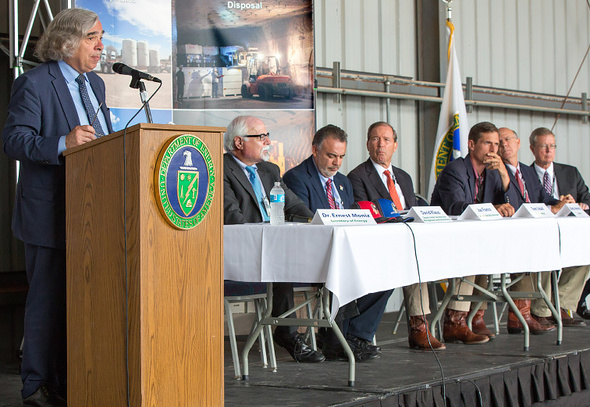 Employees from CBFO, associated DOE contractors and laboratories, elected officials, WIPP stakeholders, and leaders from New Mexico communities attended a meeting at WIPP where the Secretary (at podium) addressed the group and answered questions. Seated from left: DOE Deputy Under Secretary for Management and Performance David Klaus; Franco; U.S. Sens. Tom Udall and Martin Heinrich (N.M.); U.S. Rep. Steve Pearce (N.M.); and Bob McQuinn, president and project manager of Nuclear Waste Partnership (NWP), the WIPP management and operating contractor. 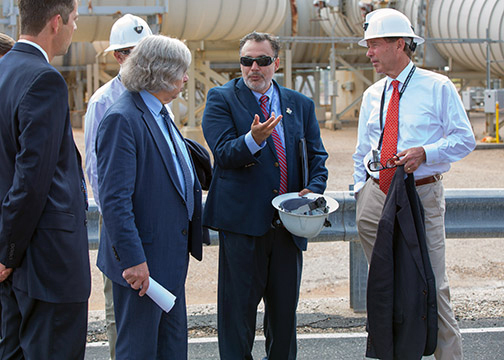 The Secretary (second from left) discusses the ventilation system at WIPP with Franco (center) and Udall (right). EM Acting Assistant Secretary Mark Whitney is on the far left. 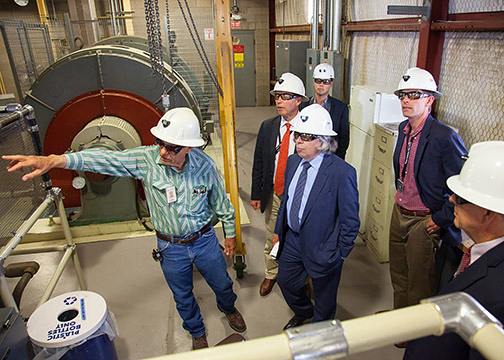 Norm Siepel of NWP explains salt hoist operations to the Secretary (center, foreground); Udall (second from left); Heinrich (second from right); Pearce; and Jonathan Black of Udall's office (far background). Energy Secretary Ernest Moniz Talks with SRS Workforce, Meets with Stakeholders 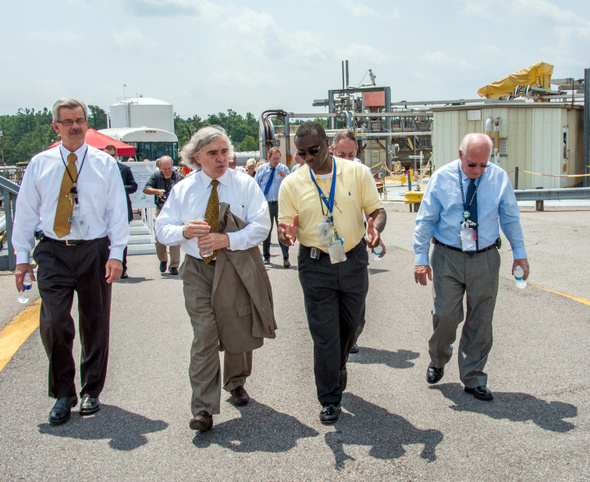 From left, Dr. Terry Michalske, director of EM's Savannah River National Laboratory and executive vice president of Savannah River Nuclear Solutions, Energy Secretary Ernest Moniz, Savannah River Waste Disposition Operations Director Phillip Giles, and Savannah River Operations Office Manager David Moody are pictured walking at H Tank Farm. AIKEN, S.C. – Energy Secretary Ernest Moniz recently visited the Savannah River Site (SRS), where he toured facilities, spoke with the site's workforce, and met with stakeholders from surrounding communities in South Carolina and Georgia. South Carolina Gov. Nikki Haley, U.S. Sens. Lindsey Graham (S.C.) and Tim Scott (S.C.), and U.S. Rep. Joe Wilson (S.C.) joined Moniz as he addressed the workforce. The Secretary thanked the delegation for its continued leadership and commended site employees for their dedication and contributions supporting U.S. defense programs and environmental cleanup progress. "For over six decades, you have built a legacy of global leadership in nuclear science and engineering. Your motto is 'We Deliver,' and you have," Moniz said. "You have successfully created a strong culture of safety here while continuing to make important contributions that support our nation's defense and environmental quality, as well as innovative energy technologies."  | |
The Secretary speaks with site employees at an all-hands meeting during his visit to SRS. | The Secretary talked with employees as he visited the K Area Plutonium Storage, the Mixed Oxide Fuel Fabrication construction site, Defense Waste Processing Facility, H Tank Farm, H Canyon, and Savannah River National Laboratory's Energy Materials Research Center. His visit ended at a community forum with local elected officials and community leaders. Participants discussed the site's priorities and role in national security, environmental stewardship, and clean energy. DOE Under Secretary for Nuclear Security and NNSA Administrator Lt. Gen. Frank Klotz accompanied the Secretary on the visit. Savannah River Site's H Canyon Work Ensures Future Missions for Facility  Workers remove an old door during H Canyon facility modifications. AIKEN, S.C. – EM and its primary contractor at the Savannah River Site (SRS) safely completed 16 facility modifications three months ahead of schedule in support of the continued operation and sustainability of the H Canyon facility. The project undertaken by EM and Savannah River Nuclear Solutions (SRNS) consisted of facility modifications and repairs, revisions to the safety analysis and reference documents, and implementation activities, including procedure changes and personnel training. "H Canyon continues to show its flexibility, despite its age, through its ability to run new missions," EM Nuclear Materials Stabilization Assistant Manager Patrick McGuire said. "DOE and SRNS will continue work to safely improve the national assets we have at SRS." H Canyon is the only hardened nuclear chemical separations plant still in operation in the U.S. The building resembles a canyon because the processing areas resemble a gorge in a deep valley between steeply vertical cliffs. The facility is currently dissolving and purifying a variety of nuclear materials and preparing nuclear materials for disposal. "The recent H Canyon upgrades ensure the facility, constructed in the 1950s, meets current safety standards for nuclear facilities and is available for future missions," said Paul Hunt, senior vice president of EM Operations for SRNS. Despite the heat and humidity of a South Carolina summer, workers safely sealed abandoned piping, and replaced doors and upgraded High Efficiency Particulate Air (HEPA) filters in the central exhaust system. "With such a complex and hazardous project, and with the number of people involved, more pre-planning, mockups and oversight were conducted to ensure the work would be performed safely and without incident," SRNS Executive Vice President and Chief Operations Officer Fred Dohse said. "It is a testament to the safety consciousness of our workforce that so many groups came together and safely completed the project. In this project, like many others in our company, we were truly our brother's and sister's keeper." Ventilation System to Improve Savannah River Site's Liquid Waste Operations 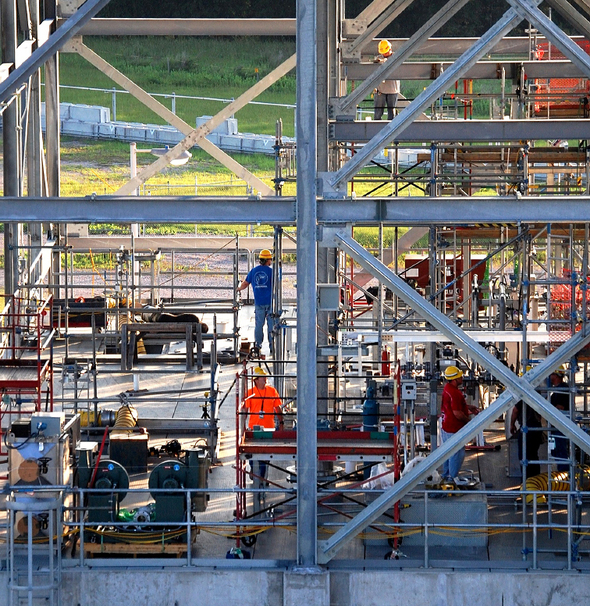 A process vessel ventilation system is being installed in a facility that houses two tanks that will process decontaminated salt solution at the Saltstone Production Facility. AIKEN, S.C. – The EM program and its liquid waste contractor at the Savannah River Site are improving salt waste disposition work and preparing for eventual operations of the Salt Waste Processing Facility (SWPF) currently being constructed. EM and Savannah River Remediation (SRR) are installing a process vessel ventilation system in a facility that houses salt solution receipt tanks at the Saltstone Production Facility. When operational, these tanks will receive decontaminated salt solution, which will be turned into a grout mixture and permanently disposed of in disposal units. "The process vessel ventilation system is a vital part of the success of SRR's liquid waste mission and an enhancement to the safety of our project," said SWPF Project Integration Manager Keith Harp. "The system being installed has an environmental monitoring system that prevents any breakthroughs into the environment." The ventilation system will keep the facility housing the salt solution tanks in a negative pressure to prevent release of unwanted contamination into the environment. Outside air is pulled through the tanks by the ventilation system, which prevents buildup of hydrogen gas inside the tanks. The system is designed to filter and monitor the air from the tanks before it is released into the environment. SRR President and Project Manager Stuart MacVean says the new system will be of great assistance to the start of SWPF. "Not only is it going to help SWPF operations, but this new system will also improve the flexibility of current salt processing within the liquid waste facilities," MacVean said. The tanks will aid the Modular Caustic Side Solvent Extraction Unit as it increases production rates. This unit's equipment takes high-activity salt solution and divides it into two waste streams. One stream, the decontaminated salt solution, is transferred to a 4,000-gallon vessel at the Saltstone Production Facility. The salt solution receipt tanks, which are scheduled to be operational in July 2015, will provide up to 120,000 gallons of space with improved ventilation. EM Headquarters Hosts British Research Scholar WASHINGTON, D.C. – For the first time in four years, EM headquarters is hosting a research scholar from the United Kingdom. David Ward, a recent University of Nottingham graduate, arrived from England's National Nuclear Laboratory (NNL) this summer to support EM's WTP and Tank Farm Program Office. That office is the program sponsor for the Waste Treatment and Immobilization Plant and tanks farms at the Hanford site in Washington state. When complete, it will be the world's largest radioactive waste treatment plant, designed to process and stabilize 56 million gallons of radioactive and chemical waste currently stored at Hanford. Ward's five-month EM assignment is hosted by nucleargraduates, a two-year British training program that provides varied experiences in the nuclear industry. The selection process is competitive, with more than 3,000 applicants vying for less than 50 spots annually. Each scholar typically completes three eight-month residencies and additional training. Industry sponsors pay the scholars' salary as well as travel and lodging expenses. In 2007, the U.K.'s Nuclear Decommissioning Authority (NDA) created nucleargraduates to help develop a new generation of nuclear professionals. NDA is responsible for cleaning up the legacy left by 20 former nuclear industry sites in Great Britain. Much like EM, many NDA sites have decommissioning challenges stemming from facilities used in the 1940s and 1950s. "In 2012, EM signed a statement of intent with the NDA on the management of radioactive waste and nuclear materials. It also allowed for assignment of personnel between the two organizations," said Rod Rimando, senior technical advisor for the WTP and Tank Farm Program Office, who interviewed Ward. 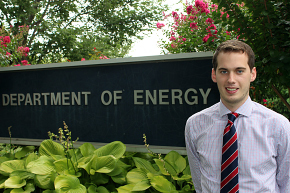 | |
British Research Scholar David Ward | Raised in England's East Midlands, Ward interned at the National Environmental Research Institute in India before earning his master's degree in chemical engineering in 2013. He joined the nucleargraduates program, and for 10 months took assignment as a research technologist for the NNL, a government-owned and operated nuclear services technology provider. While there, he worked on vitrification, a process to seal high-level radioactive waste in glass to stabilize it for long-term storage. "My last and next assignments deal with vitrification, and with a desire to experience government oversight and management, EM's WTP and Tank Farm Program Office is a brilliant fit," Ward said. Rimando said EM will benefit from Ward's assignment. "With David's recent vitrification experience at NNL, we hope to learn from him as he will learn from us," Rimando said. Ward's goals at EM are to develop a working knowledge of its Cold War cleanup program, gain practical real-world experience in EM cleanup efforts and government business operations, and identify reciprocal opportunities for the U.S. and U.K. nuclear industries. "I hope to use my experience not only to gain expertise, but to help to continue building the relationship between the U.K. and U.S. programs," said Ward. His next residency will be at Sellafield, the U.K.'s nuclear reprocessing site located on the west coast of England, where he looks forward to becoming a vitrification systems engineer. Retiring Procurement Official Reflects on Career LEXINGTON, Ky. – As the retiring supervisory contracting officer for EM's Portsmouth/Paducah Project Office (PPPO), Pamela Thompson exemplifies the wisdom of her own advice. She credits her diverse 37-year federal career to confidently seeking new challenges while she climbed the civil service ranks to positions where she oversaw billion-dollar cleanup projects and nine-figure contracts. "You can't expect to learn all you need to learn in one place. You need broad-based experience if you're going to have a satisfying career," she said. After graduating from the University of Missouri-Rolla (now the Missouri University of Science and Technology), Thompson worked at a semiconductor manufacturing plant in California before returning to Missouri where she joined the civil service with the Veterans Administration hospital in Columbia, Mo. She later joined the Department of the Army where she began her contracting career, and then the Department of the Navy, where she became a liaison contract specialist and worked on major defense procurement packages at the China Lake Naval Air Weapons Station in California. "There was a lot of innovative work there because it was research and development and it was during the Strategic Defense Initiative," Thompson said, referring to President Ronald Reagan's missile-defense strategy, dubbed "Star Wars" by many at the time. Working with supercomputers, superconductors, and fiber optics to develop cutting-edge lasers and weapons in the 1980s, Thompson faced myriad challenges, including a trade embargo while ensuring competitive contract acquisitions in the Cold War. Thompson's group supported work on submarine- and air-based systems, including Harpoon cruise missiles, Sidewinder air-to-air missiles, and even an early drone program. Thompson joined EM in 1995 and was assigned to Weldon Spring, in the St. Louis area. The facility previously processed uranium ore into metal feed material sent to the Portsmouth and Paducah gaseous diffusion plants in Ohio and Kentucky, respectively, to be enriched. The Weldon Spring site closed when operations were consolidated at its sister site Fernald in Ohio in 1966. "From 1995 through 2004, the site remediation completion was under budget and ahead of schedule," Thompson said of Weldon Spring. "It was left with beneficial reuse, including prairie plants, a college extension campus and an interpretive center maintained by the college. There are long-term monitoring wells still maintained by DOE." 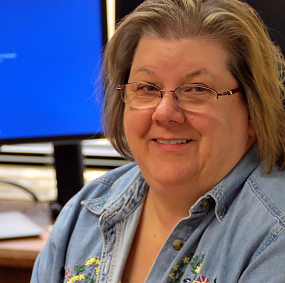 | |
Pamela Thompson is retiring from her 37-year federal career. | During her last two years at Weldon Spring, Thompson worked as both contracting officer and project manager. In 2004, she joined the newly formed PPPO, where EM manages the former gaseous diffusion plants. The work there includes environmental remediation, deactivation and decommissioning, and depleted uranium hexafluoride (DUF6) conversion. "I have known Pam Thompson for two decades, and her dedication over the past decade as the senior procurement official for PPPO has been integral to our mission accomplishment," said William E. Murphie, PPPO manager since the office's inception. "Her experience and institutional knowledge will be sorely missed. We wish her all the best in her future endeavors." Over the years, PPPO has had a major focus on awarding contracts to small businesses, and four small business contractors working for PPPO have won DOE Small Business of the Year awards. "I especially enjoy mentoring and helping the very small businesses be successful," Thompson said. "Seeing them now being able to compete and win awards, that's exciting." Innovation and creativity are hallmarks of PPPO, Thompson said. She pointed to the current effort to negotiate a sales agreement for some of EM's inventory of depleted and off-specification uranium as an example. "To be creative, you have to know your regulations and be able to bring people along and explain why even though something has never been done before, it's still allowable and a good idea," she said. As contracting officer for the DUF6 conversion project, Thompson has been significantly involved with the first-of-their-kind plants that convert EM's inventory of DUF6 to uranium oxide for disposition and hydrofluoric acid for industrial use and will continue to do so for decades. "In civil service you can take part in positive activities like cleaning up a disposal site or perfecting a weapon that minimizes impacts to civilians," said Thompson. "You can get opportunities to point to something and say, 'I was part of that.'" Paducah Site Interns Learn About EM Opportunities 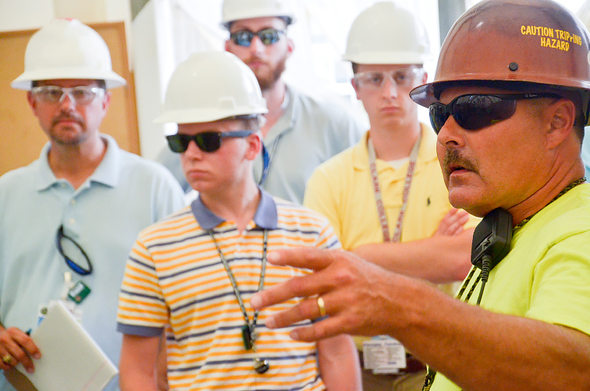 LATA Kentucky groundwater cleanup site superintendent Donnie Bell, far right, describes the project to (from left) Steve Christmas of LATA Kentucky and interns Weston Loyd, Matthew Jehnke, and Wesley Morgan. PADUCAH, Ky. – Thirteen college students took a break from the books to participate in a summer internship program hosted by LATA Environmental Services of Kentucky, the cleanup contractor at EM's Paducah site. The students, who connected classroom topics with real world experience, came from the University of Kentucky (UK), the UK College of Engineering-Paducah, and Murray State, Western Kentucky, Ohio State, and Michigan State universities. Jennifer Woodard, EM Portsmouth/Paducah Project Office (PPPO) Paducah Site Lead, spoke to the interns at weekly mentor presentation meetings. The interns are pursuing careers in engineering, business, information systems, and health and safety. Woodard told the group about her education and career background that positioned her for her current role. "The Department has a lot of opportunities across the nation. On USAjobs.gov you can see all of the open positions with the federal government. The opportunities are vast," Woodard said. "Even though you are doing your internship in the cleanup world, it is an experience that lends itself to some very interesting jobs across the nation."  Paducah site interns, from left, Mallie Myers, David Veach, Weston Loyd, Cody Barnes, Michaela Jones, Matthew Jehnke, Cassee Layne, Cameron Conte, Logan Warriner, Devin Dorrough, Wesley Morgan, Zane Smithson, and Lauren Shaw. The 10-week internship, which ended in August, was an opportunity for interns to receive hands-on experience and a realistic perspective of these types of jobs. Students worked directly with LATA Kentucky personnel and interfaced with engineers, project managers, and leaders in the business office, regulatory department, and operations department. The internship was customized for each intern because of the uniqueness of each department and the dynamic nature of projects. "Working under a project manager of a government contractor is very different from anything else I've experienced before," said Logan Warriner of Paducah, a UK-Paducah senior. "I was immersed in the administrative and managerial aspect of engineering, something completely new and exciting that I've never seen before in school or at other internships." Interns benefited from familiarizing themselves with the site and participated in weekly presentations prepared by experts in groundwater, waste disposal alternatives, waste disposition, environmental monitoring, and document production. "I was so impressed with the interns, their professionalism and ability to dive into such complex projects," said Elizabeth Wyatt, waste disposal alternatives project manager for LATA Kentucky. "They were eager to learn and blew me away by how quickly they were able to jump in and help out. It was a great summer." Cleanup Contractor at Paducah Site Receives Performance Excellence Award  From left, Colmon Elrige, executive assistant to Kentucky Gov. Steve Beshear; Jennie Freels, quality assurance support and programs manager; and Michelle Dudley, quality assurance manager. Freels and Dudley are with LATA Environmental Services of Kentucky. PADUCAH, Ky. – The environmental cleanup contractor at EM's Paducah site has been honored for demonstrating serious commitment to performance improvement principles. LATA Environmental Services of Kentucky received an award for Performance Excellence, Level II – Commitment, from the Kentucky Center for Performance Excellence (KYCPE). The organization honors organizations based on the demonstration of performance excellence practices at one of four levels: interest, commitment, achievement, and excellence. Michelle Dudley and Jennie Freels of LATA Kentucky's quality assurance organization received the honor at the 2014 Annual Best Practice Sharing Conference for KYCPE. Colmon Elrige, executive assistant to Kentucky Gov. Steve Beshear, presented the award. An all-volunteer organization, KYCPE promotes the Baldrige Criteria for Performance Excellence in Kentucky and employs an innovative approach to assessing operational performance by using a nationally recognized program implemented at a state level. The program provides feedback on strengths and potential areas of improvement from highly experienced examiners. With the feedback, organizations are recognized for their current performance level in accordance with the criteria. Unlike contracted third-party audits, this process provides a fully independent comprehensive review of performance across the organization. The feedback is useful in the strategic planning process by building on strengths and addressing opportunities for improvement, said Dudley, a quality assurance manager. "The process assists in finding gaps and strengthens methods of measuring, monitoring, and implementing all processes to demonstrate effectiveness and support improvements," Dudley added. "The application process alone helps organizations identify areas for improvement while supporting changes that increase performance and competitiveness." Feedback received from the application provides additional opportunities for improvement and a reinforcement of best business practices already in use. "Safety is of utmost importance to LATA," according to the feedback report from examiners. "The Integrated Safety Management System—Environmental Management System is designed to apply execution and a monitoring process that support safe and compliant performance of the workforce in completion of LATA's mission." Examiners also found strengths in LATA Kentucky's processes and the annual site management plan, calling them a systematic, well-deployed approach to strategic planning. "Cycles of learning are proven by the use of lessons learned from other Department of Energy Environmental Management Projects," according to the evaluation. Examiners said these processes allow LATA Kentucky to respond quickly to a changing environment. Contributors Steve Ashe, Savannah River Site Steve Christmas, Paducah site Tim Boulay, EM headquarters Maren Disney, Hanford site Lindsey Evans, Savannah River Site Destry Henderson, Hanford site Kentucky Center for Performance Excellence Rick Kelley, Savannah River Site Brad Mitzelfelt, Portsmouth/Paducah Project Office Dylan Nichols, Paducah site Amy Scales, Savannah River Site David Sheeley, EM headquarters Ryan Williamson, Waste Isolation Pilot Plant | 


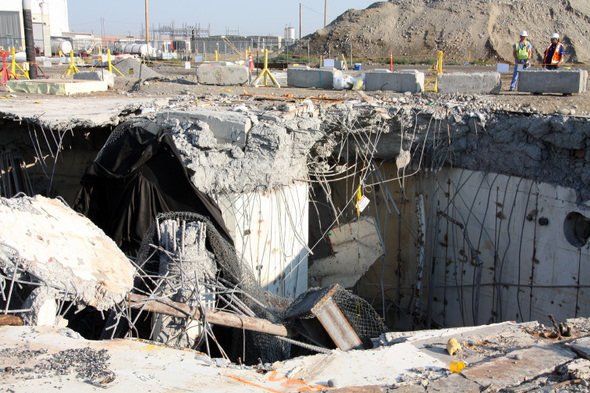
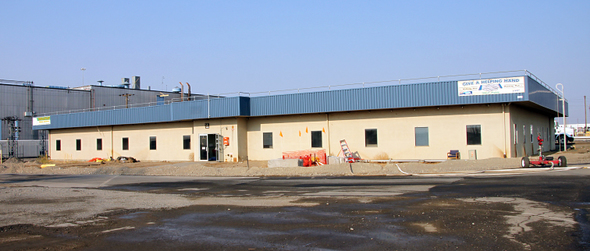






















No comments:
Post a Comment